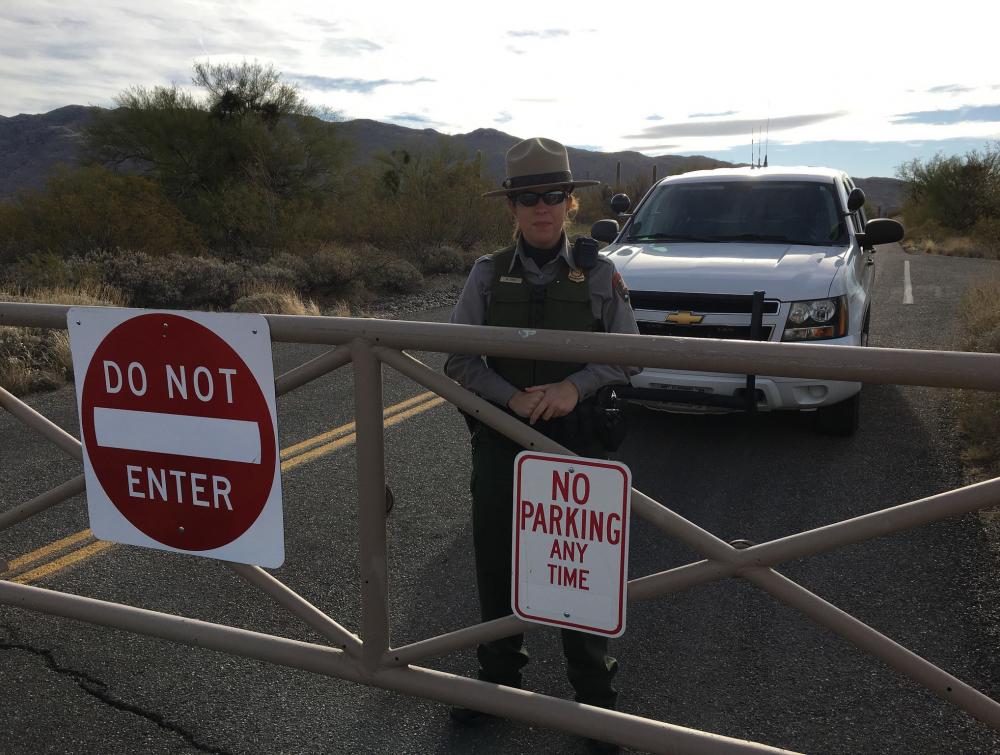Confusion reigned in semi-shut-down national parks

Saguaro National Park under partial closure during the early 2018 government shutdown.
NPCA, Flickr
Visitors to public lands encountered locked doors, ambiguous instructions
The third weekend in January kicked off with a federal government shutdown. At least some Americans went ahead with their plans to visit national parks and other public lands, perhaps heartened by Interior Secretary Zinke's imprecise (yet exhaustively publicized) plan to keep them open.
But by one estimate, one-third of National Park Service-administered sites ended up closed on Saturday, the first day the shutdown was in effect. This included the Statue of Liberty and Ellis Island, which quickly became the most visible symbols of both the shutdown's effects and the dysfunction surrounding Zinke's plan (as a vacationing firefighter told Fox News, blaming unspecified politicians, "they really kind of screwed up our day"). New York Governor Andrew Cuomo later said he'd use state funds to ensure the sites stay open.
While most rangers were off work, two visitors to Yellowstone were able to violate park rules by driving snowmobiles too close to Old Faithful
That still left hundreds of parks theoretically open for people to enjoy, not to mention a variety of national monuments, national wildlife refuges and other public lands. And indeed, some parks were open—sort of. Per media accounts, visitors were met by a variety of staffing contingencies, you're-on-your-own placards, closed visitor centers and even shuttered restrooms. At some parks, reduced search-and-rescue capacity and unsupervised roadways raised doubts about whether it was even safe to forge ahead.
Since park staff also serve a vital role protecting the land itself, the shutdown allowed at least some reckless behavior to creep in. At Yellowstone National Park, a concession operator allowed two clients to drive snowmobiles too close to Old Faithful, violating park rules while most rangers were off work.
Many people trying to enjoy their public lands over the weekend encountered mixed messages. At Maryland's Blackwater National Wildlife Refuge, 62 miles from the White House as the crow flies, visitors were greeted by a locked gate—but also a sign explaining that, without staff, they could enter at their own risk.
The through-line of the signs, website updates and other communiques tasked with explaining the shutdown status was ambiguity.
Washington's Mount Rainier National Park and Colorado's Rocky Mountain National Park posted similar notices on their websites warning visitors that staff would be unable to provide the usual level of assistance or emergency response. But come Sunday, the former tweeted a seemingly straightforward 'open for business' message ("Mount Rainier National Park Accessible to Public during Government Shutdown"), while the latter was still sharing an old tweet advising guests that "Some RMNP areas are accessible, however access may change without notice." Each park ranks among the nation's most dangerous as measured by yearly fatalities; leaving them on a semi-operational status and offering protean or unclear messages to the public seems like a recipe for disaster.
Shutdown a reminder of Trump administration's uniquely poor conservation record
While all this was playing out, Secretary Zinke, showing the same knack for publicity that has led him to fly a personal flag at the Department of the Interior and ride a horse to his new office, churned out social media posts that showed him greeting visitors to the National Mall, suggesting everything was proceeding as planned.
The confusion at public lands underscored the incoherence of the Trump administration, which pays lip-service to the giants of American conservationwhile working feverishly to undermine their achievements. A couple days after Zinke posed for photos, with the shutdown still in effect, he signed an agreement authorizing a land exchange and construction of a needless road through Alaska’s Izembek National Wildlife Refuge and its designated wilderness area. Fittingly, that agreement was the product of backroom dealings and a process that shirked transparency and ignored previous studies on the proposal. Say one thing, do another.
Keeping some parks open didn't undo the misdeeds of what is already a uniquely damaging presidency.
